
Saqqara: A Stunning, Sprawling, Necropolis of Egypt
Picking the most important or the most interesting site in Egypt is next to impossible. The country is a treasure trove of ancient sites. While the Valley of the Kings and Pyramids of Giza get the most press these days, we mustn’t forget about Saqqara. This amazing site acted as the necropolis of ancient Egypt’s capital, Memphis, and includes a number of impressive pyramids and royal tombs.
Where is Saqqara?
Saqqara is one of Egypt’s most impressive ancient sites. Located roughly 18 miles (30 kilometers) south of modern Cairo, it covers an area of 4.3 miles (7 kilometers) by 1 miles (1.5 kilometers). Today, many of the pyramids are in poor states of preservation, meaning the site isn’t as well-known as sites like the Valley of the Kings and Pyramids of Giza.
More than sixteen Egyptian kings built pyramids at Saqqara. Over time, the site became less popular for royal burials but remained an important site for important non-royal burials and cult ceremonies for over 3,000 years.
Today, the site is most famous for The Pyramid of Djoser, the oldest known complete stone building complex. Saqqara is listed as a UNESCO World Heritage Site and is home to the Imhotep Museum, which offers a fascinating window into the daily lives and culture of Ancient Egypt.
- Was Tutankhamun’s Tomb built for a Female Pharaoh?
- The Golden Shrine of Queen Tiye: How Did It Reach the Theban Necropolis?

A map of the Saqqara necropolis from 1849 demonstrates its impressive size and numerous monuments (Public Domain)
Saqqara’s Very Long History - Early Dynastic Origins
Saqqara’s history stretches back to the Bronze Age during ancient Egypt’s first dynastic period. When exactly this period began is the subject of much scholarly debate, but it is thought to have begun between the 30th and 34th centuries BC.
During this period, the main royal burial area was at Abydos, but Saqqara was used for the burials of important nobles. By the Second Dynasty (2890- 2686 BC), Saqqara was being used for royal burials.
For example, Khasekhemwy had his main burial at Abydos but also had a large funerary monument built at Saqqara, the Gisr El-Mudir. This tomb is believed to be one of the oldest stone structures found in Egypt. This inspired other early dynastic rulers to follow suit and have monuments to themselves built at the site. Both King Hotepsekhemwy (or perhaps Raneb) and King Nynetjer also had impressive tombs at Saqqara.

Statue of Khasekhemwy, circa 2690 BC. He was the last pharaoh of the Second Dynasty, and the first to build a monument at the Saqqara necropolis. (Anthony Huan / CC BY SA 2.0)
Old Kingdom
The Old Kingdom (2686-2125 BC) was a period of ups and downs for Saqqara. King Djoser had his funerary complex built there during the Third Dynasty (2670-2650 BC) but then nearly all the Fourth Dynasty kings chose different locations for their pyramids, perhaps not wanting to compete with Djoser.
By the Fifth and Sixth Dynasties of the Old Kingdom’s latter half, the Saqqara necropolis was back in favor as the preferred royal burial ground. The constructions of these later kings weren’t quite as impressive as those of their predecessors, however.
Rather than being built wholly out of massive stone blocks, these pyramids included a cheat. Their centers include a core made of rubble. As such, these pyramids haven’t aged as well as some of their other Egyptian counterparts, like those built at Giza.
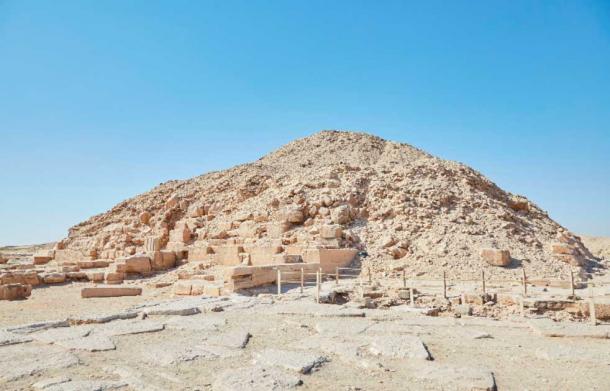
The Pyramid of Unas took some construction shortcuts, leading to poor preservation (Sailingstone Travel / Adobe Stock)
While they are not as well preserved as some other pyramids, those at Saqqara feature the earliest known example of pyramid texts, inscriptions with instructions for life after death which were used to decorate the walls of important tombs. The tomb of the last Fifth Dynasty ruler, Unas, was the first to feature these decorations.
During this period, it was also common for courtiers to be buried alongside their king. Saqqara has clusters of private tombs that encircle the pyramid complexes of Unas and Teti. During the Old Kingdom, many tombs were built at Saqqara.
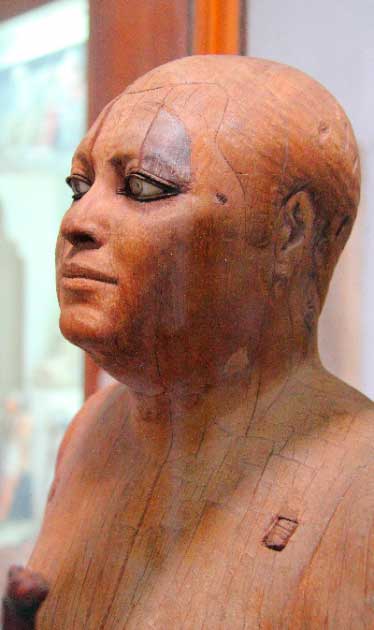
Wooden statue of high rank official Kaaper, Old Kingdom, (around 2500 BC) (Djehouty / CC BY SA 4.0)
Important Monuments of the Old Kingdom
Pyramid of Djoser
The most impressive monument to be found at Saqqara is probably the Pyramid of Djoser. This six-tier, four-sided step pyramid was built during the 27th century BC by the architect Imhotep, Djoser’s chancellor.
The pyramid has dominated the Saqqara landscape for millennia. It is believed the pyramid was originally 200 feet (62 meters) tall and clad in polished marble. This early type of proto-pyramid set several important precedents that later kings would follow; the main one being the new trend of pharaohs building massive monuments.
Nothing like it had ever been attempted before. The fact that Djoser managed to build it represents how powerful the Egyptians had become by this point. The pyramid's construction would have demanded a level of labor and resources that few kings before Djoser would have been able to muster.
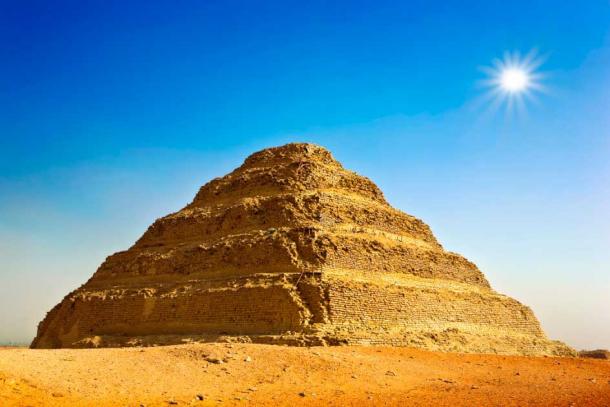
The Pyramid of Djoser in Saqqara necropolis is Egypt’s oldest pyramid (WitR / Adobe Stock)
Sekhemkhet's Step Pyramid
Pyramids took a long time to build and weren’t always finished by the time of their benefactor’s death. While most kings who followed Djoser wished to rival his step pyramid, not all of them were successful. Sekhemkhet’s pyramid was never actually finished; in fact, the builders never got past its lowest step.
The pyramid was discovered in 1951 by Zakara Goneim. Until this time Sekhemkhet’s name, the successor of Djoser, wasn’t even known. Jar seals found on the site featured his name. While the fact the pyramid was never finished means it isn’t as impressive as some of its contemporaries, archaeologists believe that if it had been completed, it would have been.
It is thought that the pyramid’s architect was the same as Djoser’s, Imhotep. Archaeologists believe Imhotep set out to beat what he had done with Djoser’s funerary complex but bit off more than he could chew. If the pyramid had been finished, it would have been much larger than Djoser’s. Today what is left of the unfinished pyramid still lives beneath the sands and is known as the “buried pyramid”.

Sekhemkhet’s pyramid was never completed, but the plans were very grand. It’s now known as the buried pyramid. Left: Purported plans for the pyramid; Right: the rubble that remains in Saqqara (Left: GDK / CC BY SA 3.0; Right: Pottery Fan / CC BY SA 3.0)
Userkaf's Pyramid
Userkaf’s pyramid is one of those that feature a rubble core. This means that compared to other pyramids it hasn't aged very well. Located just north of Djoser’s step pyramid, today Userkaf looks more like a hill than a pyramid.
- The Sacred Link Between Architecture and the Divine Across Ancient Cultures
- Tomb of Egyptian Dignitary Who Guarded Top Secret Documents Found in Saqqara
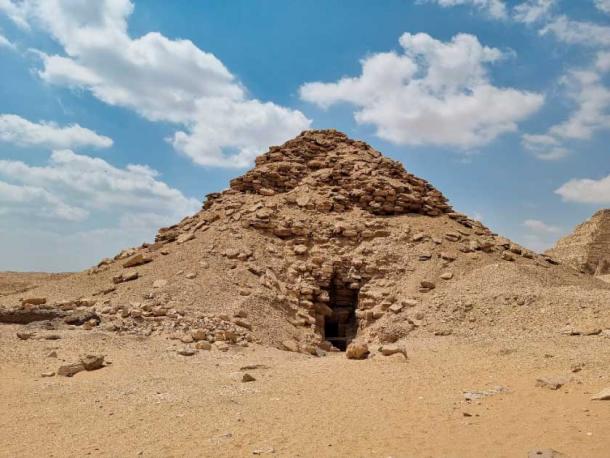
Early pyramids at Saqqara necropolis like Userkaf’s pyramid provide insight into the development of pyramid construction techniques (Prof. Mortel / CC BY SA 2.0)
John Shae Perring was the first archaeologist to enter the pyramid in 1839 via a robber’s tunnel that had been found eight years prior by Orazi Marucci. For a long time, the pyramid was misidentified, and it wasn’t until 1928 that the Egyptologist Cecil Firth figured out who the pyramid had once belonged to.
The pyramid’s design saw several changes from those of earlier kings. For a start, it is smaller, less than 160 feet (50 meters) high, and with sides that are only 230 feet by 100 feet (70 meters by 30 meters) long. It would seem that rather than focusing on beating the pyramids of his predecessors in size, Userkaf chose to focus on beating them in grandeur. While his pyramid may not have been as large as some of the others found at Saqqara, it is among the most extravagantly decorated.
Pyramid of Unas
Much like the pyramid of Userkaf, the pyramid of Unas isn’t that impressive to look at today from the outside. It too resembles more of a hill than an elegant royal tomb. The inside, however, is a different story. When it was first entered in 1881, the pyramid of Unas proved to be a significant discovery.
Inside the pyramid of Unas, Gaston Maspero, the first man to enter the pyramid, found a series of texts covering the walls, now known as the pyramid texts. Inside the pyramid's burial chamber, the remains of an incomplete mummy were discovered. Only the skull, right shin, and right arms were left. Due to their poor state, it is unclear whether they are the remains of Unas or not.
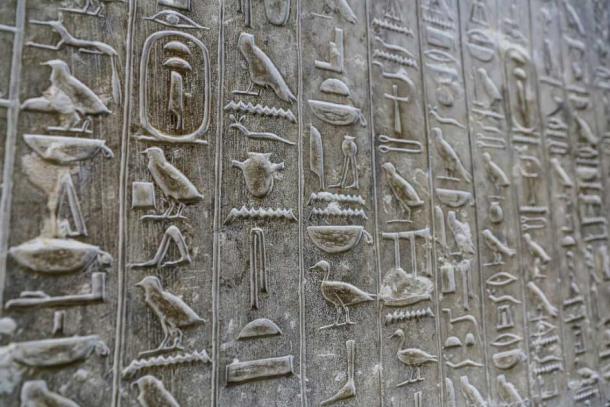
The pyramid inscriptions at the Pyramid of Unas at Saqqara necropolis, the first known to have these decorations (EvrenKalinbacak / Adobe Stock)
Teti’s pyramid complex
The sixth dynasty saw a shift in the balance of power in ancient Egypt. During Teti’s reign, officials began to build funerary monuments that rivaled those of their pharaoh. Teti’s pyramid is closely associated with the tombs of his officials, which rival Teti’s pyramid in grandeur. Take, for example, Teti’s chancellor who had a large mastaba built that included 32 richly decorated rooms.
Today, the pyramid isn’t much to look at from the outside. Its exterior is poorly preserved and, much like other Egypt’s from the period, resembles a small hill. Thankfully, the interior is in a much better state and its elegantly decorated corridors have given historians a window into the past.
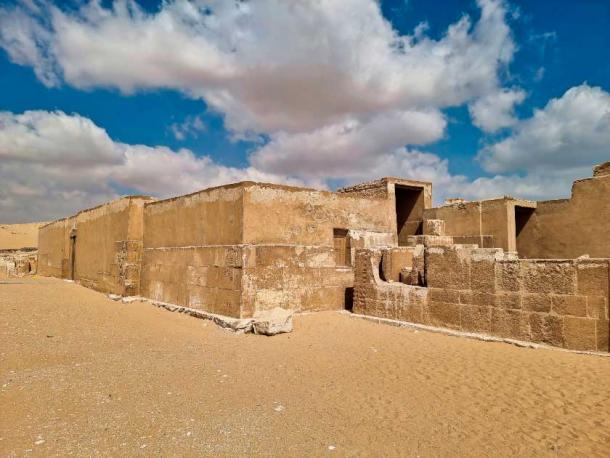
The 32 room mastaba of vizier Mereruka rivalled Pharoah Teti’s monument in size and grandeur, and is better preserved than his master’s tomb today (Prof. Mortel / CC BY SA 3.0)
Pepi II Pyramid Complex
Pepi II’s reign was a long one, and this is reflected in his pyramid complex. His pyramid itself is relatively modest compared to those of his predecessors. Upon its construction, it was around 255 feet (78 meters) high, but due to poor construction now measures only 164 feet (50 meters) high.
Pepi’s pyramid is only one part of a large funerary complex he had built. His pyramid is surrounded by the pyramids of three of his wives. The pyramid of Neith is to the north, Iput II is to the North-West, and Udjebten to the southeast. Each has its own mortuary complex.
Towards the end of Pepi’s long reign, his kingdom began to decline. As such, his fourth wife drew the short straw. Rather than getting her own pyramid, she was buried in the store room of Iput’s mortuary chapel. Similarly, Pepi’s son, Prince Ptahshepses, didn’t get his own pyramid. Instead, he was buried in Unas’s funerary complex. He didn’t even get his own sarcophagus; he was buried in an old Fourth Dynasty one.
While the exterior of Pepi II’s pyramid may not be much to write home about, the same cannot be said for the inside. Following in the footsteps of his predecessors, Pepi chose to focus on the decoration of his tomb. The ceiling of his burial chamber is decorated with stars and its walls are lined with passages from the pyramid texts.
These magical spells were meant to protect the dead, but it seems they didn’t work. The large black sarcophagus found in the center of the burial chamber was empty when the chamber was first entered in 1926. Of the 800 pyramid texts found so far, Pepi’s chamber has 675.
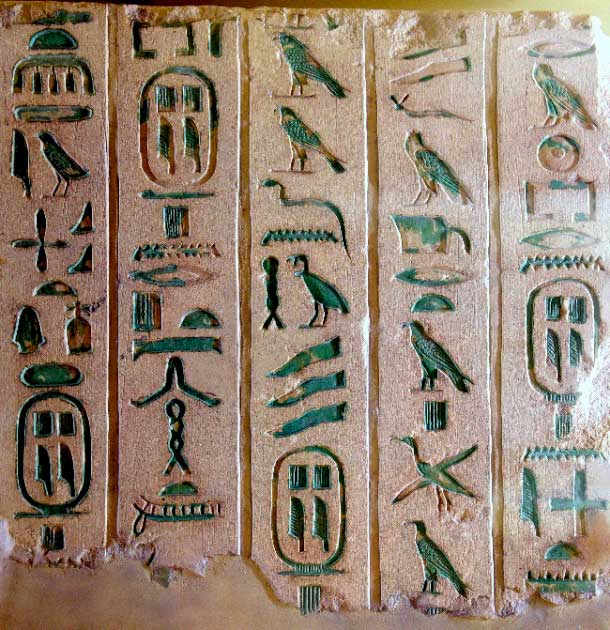
Pharoah Pepi’s Sixth Dynasty tomb contains the majority of the pyramid texts discovered so far. The inscriptions describe the formula for the ascent of the king to heaven and for his eternal supply of food and drink. (Osama Shukir Muhammed Amin / CC BY SA 4.0)
Middle Kingdom
Saqqara saw a period of decline during the Middle Kingdom. From this point onwards, Memphis was no longer ancient Egypt’s capital, which meant kings tended to have their tombs built elsewhere. This means that compared to the Old Kingdom, the Middle Kingdom saw very few private monuments being built.
During this period, only the Pyramid of King Khendjer (Thirteenth Dynasty) and the pyramid of an unknown king were built. The Pyramid of Khendjer originally stood at a relatively humble 121 feet (37 meters), but is completely ruined today. It is believed to be the only pyramid completed during the 13th dynasty.
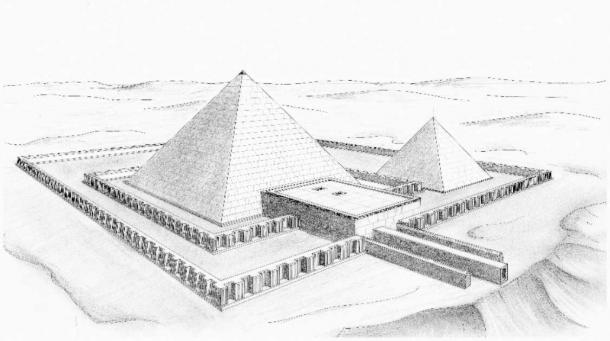
The Pyramid of Khendjer is the only pyramid known to be completed in the Thirteenth Dynasty. Although it’s ruins today, archaeologists have reconstructed its plans (MonnierFranck / CC BY SA 3.0)
New Kingdom
Saqqara saw a resurgence during the New Kingdom. Following the Amaran period, Memphis became the capital and was an important military and administrative center. From the Eighteenth Dynasty onwards, Saqqara necropolis was home to the tombs of many high officials.
Before Horemheb became a pharaoh and was still just a high-ranking general, he built a large tomb in Saqqara; although after becoming king, he was buried in the Valley of the Kings.
Besides Horemheb, other important tombs were built during this period, including those of vizier Aperel, vizier Nerronpetm, the artist Thutmose, and the royal wet nurse of Tutankhamun, Maia.
By this time, the older monuments of Saqqara were still standing but had become somewhat run down. The son of pharaoh Rameses II, Prince Khaemweset, had repairs made to many of the older monuments. He had the Pyramid of Unas repaired and added an inscription to its south face which highlighted his restorative efforts.

Mural from the tomb of Horemheb, featuring Horemheb between Osiris (left) bearing the royal whip and scepter and Hathor (right) Mistress of the West, of Heaven and of all the Gods (Jean-Pierre Dalbéra / CC BY SA 3.0)
Post New Kingdom
In the periods that followed the New Kingdom, Egypt’s capital jumped between several different cities, but Saqqara remained an important noble burial ground. It also became a religious hub and an important site of pilgrimage for those wishing to visit cult centers.
Huge underground galleries were cut into the rock, becoming burial sites for the mummified remains of baboons, cats, dogs, and falcons. In short, in the years that followed the New Kingdom, Saqqara necropolis became less of a royal burial site and more of a religious site.
Conclusion
It can be a little difficult to get one’s head around just how impressive a site Saqqara is. With a history that stretches back to the earliest days of the Egyptian empire, its historical importance cannot be overstated.
Even well into the 21st century, Egyptologists are still making important discoveries at the site. Rather than being a mere graveyard, the site has been found to be an economic and spiritual center.
It is a testament to the Egyptian obsession with beating death and surviving forever. The fact that so many of these ancient monuments are still standing and still have so much to teach us is truly amazing.
Top image: The Pyramid of Djoser looms above the desert landscape in Saqqara necropolis, ancient burial ground of the elite. Source: marinadatsenko / Adobe Stock
By Robbie Mitchell
References
Marchant, J. July 2021. Inside the Tombs of Saqqara. Smithsonian Magazine. Available at: https://www.smithsonianmag.com/history/inside-tombs-saqqara-180977932
Mark, J. February 14, 2016. The Step Pyramid of Djoser at Saqqara. World History Encyclopedia. Available at: https://www.worldhistory.org/article/862/the-step-pyramid-of-djoser-at-saqqara/
Raghavan, S. April 22, 2021. In the tombs of Saqqara, new discoveries are rewriting ancient Egypt’s history. Washington Post. Available at: https://www.washingtonpost.com/world/2021/04/22/tombs-saqqara-new-discoveries-are-rewriting-ancient-egypts-history/
Shaw, I. & Nicholson, P. 2003. The Dictionary of Ancient Egypt. Harry N. Abrams.















